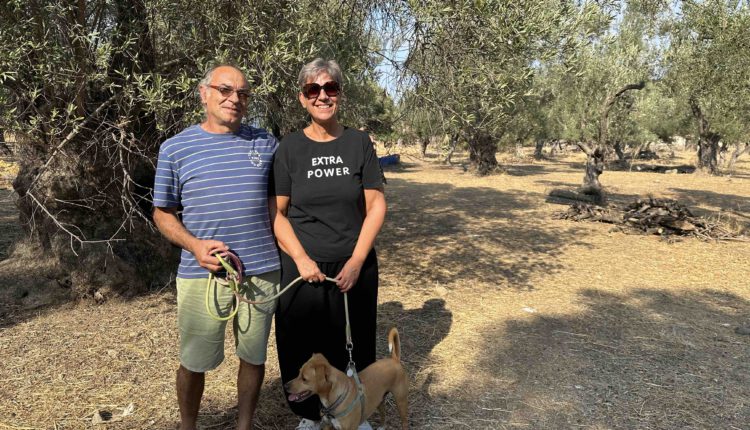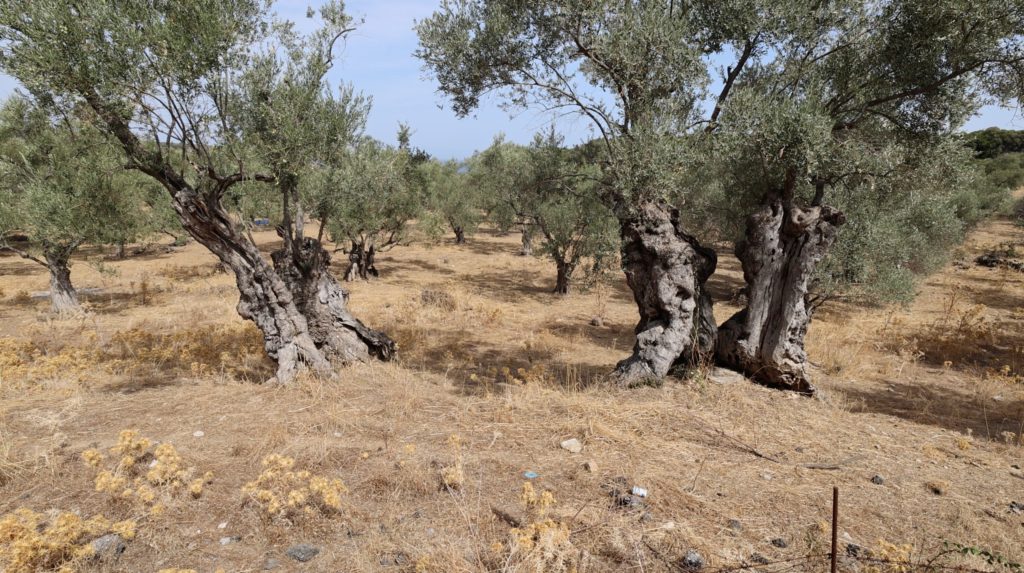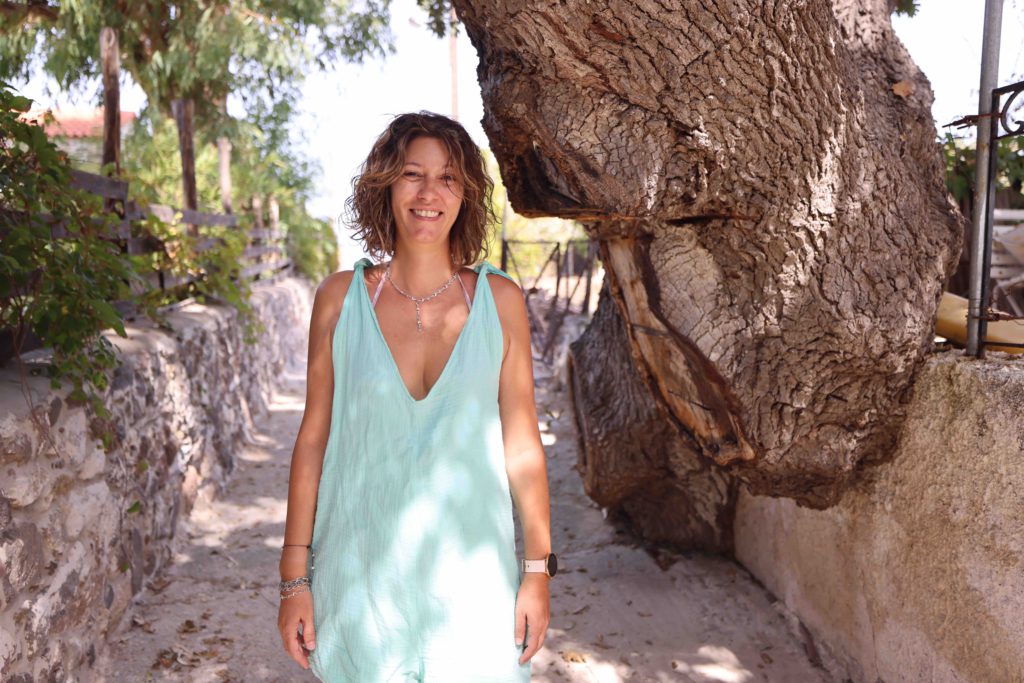
A family & their olive orchard in Lesbos
Where: Village of Mistegna, Lesbos (Lesvos), Greece 🇬🇷
“Come with me,” Effie said.
She exited her property and we began walking down a gravel path too narrow for a vehicle.
I was in Lesbos, Greece. On a trip from the island’s largest town, Mytilene, to a beautiful coastal village in the northwest, Mithimna (Molivos), I came across an olive orchard along the side of a highway with spectacular looking trees.
It was one, or two trees that caught my attention initially, and I parked the car. It was the size and comportment of the two trunks that had me suspect that the tree, or pair of trees, were at least a millennium in age. Because of the trunks’ proximity to each other and the angle in which the two grew in opposing directions, had me theorize that, while optically it was one tree, in fact, they may be one.

After speaking with another neighbour (a group of five were seated socializing on a veranda) that pointed me in the general direction of where the owner of the olive orchard was, Effie Lavejou’s home was my last stop at trying to locate the family. A male family member of hers, who I spoke to first, was unsure of who owned the orchard. It was when I was walking back down the path from which I came that Effie exited her house, having just ended a phone call, and walked onto the veranda. Her first words to me were, “One moment.”
—
“Stratoula!” Effie yelled as we walked along the boggy coastline together. We were walking in unstable terrain: Not something one could run or ride a bike in.
Neighbour, Effie Lavejou, and Andrew Schiestel, walk along the coastline in search for the owner of a nearby olive orchard.
And then someone responded in Greek from about 100 metres in the water.
“Ahh,” Effie said pointing out into the cove. “The owner is swimming.”
The owner of the olive orchard, Stratoula Kaniamou, had been found.

Effie Lavejou, a neighbour, was born to a Greek family, lived in Canada for the first six months of her life, and then moved to Lesbos with her family, where she has resided since.
A return visit
A week later I returned for a planned visit. The family’s daughter, Eleni (Helen) Manoura, translated our conversation.
“She [my mother] remembers since she was very young, around six years old,” Helen said of her mother’s earliest memories in the olive orchard. Although Stratoula wasn’t working in the field at that age herself she remembers her father and workers harvesting the olive trees.
I listened on, sipping Greek coffee that was prepared upon my visit, as Helen translated Stratoula’s words.
“My grandpa [Stratoula’s father] used to have people to work for him [from] the village, women mostly,” Helen went on. “[The women] wore a specific uniform…white leg trousers called salvari, maybe the same as the Turkish word.”
The originating family
The orchard came into the family initially through Stratoula’s mother, Eleni (Helen) Politi. Her first husband, Nikolaos Michail, who owned the orchard died, and Helen re-married to Panagiotis Kaniamos. It was this second marriage that gave birth to Stratoula, as the only child.
As we strolled towards the olive orchard, Stratoula shared that her family was originally from the Anatolian peninsula. (present day Türkiye) Stratoula’s grandparents immigrated to Lesbos around 1922, during the period of population exchange between the two present-day countries. (Greece & Türkiye) (This population exchange is also referenced from the Turkish side in the Ithacabound.com article, A little gem in Alaçatı)
Helen referenced that many families living on Lesbos today had grandparents that came from the area.
“It was the grandmother of my mother [Antonia] who at the time was very young,” Helen said, continuing to translate Stratoula (this being the mother of Stratoula’s mother). “They were afraid they were going to take her, so they made sure she looked like an old lady.” Helen shared of the fears and the precautious measures that the family took while migrating from the Anatolian Peninsula during that period of time.
Stratoula too remembers her grandmother telling her of how the family would sew valuables (“golden jewellery” and “spoons”) on the inside of their clothes so that these valuables could be transported and go undetected during the passage.
Of Stratoula’s grandmother on her father’s side, “Her grandma was from Minor Asia [Anatolian Pensinula too] who was an orphan and she came here with her sibling.”

Stratoula Kaniamou & Andrew Schiestel walk towards Stratoula’s family’s olive orchard while daughter, Helen Manoura, translates her mother’s words via telephone from Thessaloniki.
How the couple met
The two, Stratoula and George Manouras, both laughed and began blushing when I asked how the two first met.
Both from different municipalities in the northern Lesbos, George from Mytilene, and Stratoula from Mistegna (where the family home is now), the two knew of each other but would principally meet through mutual friends at a “cafeteria” in the nearby village of Thermi.
Married couple, Stratoula Kaniamou and George Manouras, speak about how they first met many years ago.
The couple would give birth to two children: Dimitris Manouras and Helen Manoura. Dimitris is an orthopedic physician principally living and working in Athens. Helen, who translated the conversation, works as a psychologist who principally lives in Mytilene in Lesbos. She currently splits her time between the island and Thessaloniki, the latter, where she does academic work.
The orchard
At 9 stremas (0.9 hectares or 2.2 acres) the demarcation of the orchard has gone unchanged since it entered the family in the early 20th century. With around 100 trees, the family harvests the orchard for both table olives and olive oil. They process their olive oil at an oil mill in the village. “Every village [in Lesbos] has their own,” Helen told me of oil mills on the island.
The orchard has four types of trees: Koloves, Adramitianes, Kalamon and another variety or varieties that is unknown with olives that appear larger in size.
The Koloves and Adramitianes are mostly used for oil. The family uses Kalamon for table olives.
“Actually this name [Adramitianes] comes from a city in Minor Asia,” Helen said.
“This year there is not many olives,” Helen shared, translating her mother.
When I asked why there weren’t many olives, George spoke most, demonstrating a lot of knowledge about the field and harvesting.
“The first is that the olive trees usually have olives every two years,” Helen said, mostly translating her father. “And the second is that it hasn’t rained enough for them [the olives] to grow.”
The family did have enough olives from the orchard though to generously give me a jar of table olives on my first visit a week earlier.
Saying Goodbye
My parting memory of the family and neighbourhood was Stratoula and George beginning to speak with a neighbour on the way back to their home. The neighbour went and fetched a cutting tool and trimmed off some flowers for Stratoula.
Stratoula told me that the neighbour gives her flowers and that she uses them as decoration at her home.
In a quiet & peaceful cove in northern Lesbos, Greece, lives a Greek family, situated amongst a friendly neighbourhood that’s full of hospitality and heart.
(The Kaniamou & Manouras olive orchard was later documented in this Documentingolives.com article)


Comments are closed, but trackbacks and pingbacks are open.